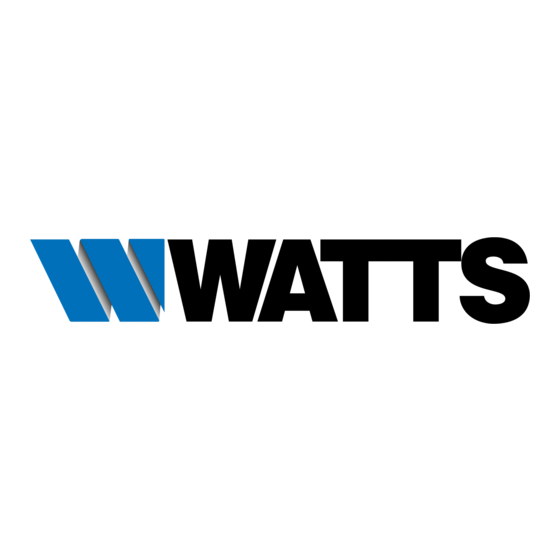Advertisement
Quick Links
Enware Pull Down Eye Wash - Bench
Mounted
Installation and Maintenance Instructions
EL486
technical data
Inlet Connection
Working Pressure Range
Maximum Static Pressure
Recommended Working
Pressure
Suggested Flushing Water
Temperature
I00628_17 Jun 2024
1300 369 273 | info@enware.com.au | enware.com.au
1/2" BSP (DN15)
Min 50 kPa Max 500 kPa
1000 kPa
210 kPa
Tepid
16°C min - 38°C max
265
R1/2" BSPT ISOLATION VALVE
50
250
220
80
130
190
Advertisement

Subscribe to Our Youtube Channel
Summary of Contents for Watts Enware EL486
- Page 1 Enware Pull Down Eye Wash - Bench Mounted Installation and Maintenance Instructions EL486 technical data Inlet Connection 1/2” BSP (DN15) Working Pressure Range Min 50 kPa Max 500 kPa 1000 kPa Maximum Static Pressure 210 kPa Recommended Working Pressure Suggested Flushing Water Tepid 16°C min - 38°C max Temperature...
- Page 2 installation compliance Before proceeding with installation ensure all operating and dimensional specifications are suitable for the intended installation. Installation of emergency showers, eye and eye/face wash equipment shall be in accordance with AS/NZS4775 or ANSI Standard Z358.1 - whichever is applicable to the installation. To meet ANSI Z358.1 and AS4775, eye wash outlets need to be between 838mm to 1143mm from the surface where the user stands.
- Page 3 installation DETERMINE EYE WASH LOCATION Outlet height 1. Position eyewash unit so that it is clear of any obstructions 838mm - 1143mm that can prevent its operation - i.e. place the unit where from oor at desired on bench and move the eye wash to “open” position, open position ensuring that the arm does not hit any obstruction and that the user can reach the unit easily.
- Page 4 IMAGE 05 COMMISSIONING 1. Turn on water supply to eyewash. 2. Turn ball valve to fully on position and check Point of fluid stream interaction for any leaks on all connections and joints. 3. Pull down the eyewash arm and test water flow.
- Page 5 operating instructions Instructions for all emergency equipment should be readily accessible to maintenance and training personnel. To turn ON, pull eyewash frame towards the user and down. SEE IMAGE 07 Water starts to flow. To turn OFF, gently lift up the eyewash frame and push away from the user.
- Page 6 maintenance The eyewash needs to be activated weekly for a period long enough to verify operation and ensure the flushing fluid is available (AS4775 & ANSI Z358.1). Note: the intent is to ensure that there is a flushing fluid supply at the head of the device, to clear the supply line of any sediment build up that could prevent fluid from being delivered to the head of the device, and to minimize microbial contamination due to sitting water.
- Page 7 troubleshooting PROBLEM CAUSE RECTIFICATION Water runs constantly, Spline seat not adjusted Turn off isolation valve, remove drips or leaks from properly eyewash body and re-tension hex nut outlet to spline seat located inside frame Debris fouling spline seat Same as above, but remove spline seat and clean before reassembly Note: Spline seat can be removed with M10 x 1.5 bolt...
- Page 8 components Aerator outlets & eyewash Cover (13Lpm) Eyewash frame Locknut 1/2” BSP Ball valve O-ring BS116 Mounting insert Tail 1/2” BSP Ball spline seat Locknut 10 Eyewash mounting 11 Grub screw - rolling tip 12 Grub screw - cone tipped 13 Wave pin 14 O-ring BS030 15 Ball spline bush...
- Page 9 AS4775 Safety Equipment Minimum Performance Checklist Installation shall be in accordance with proper plumbing practices. Supply piping shall be adequately sized to meet flow requirements. (Sec D1) All plumbed emergency equipment shall be connected to a continuous source of flushing ...
- Page 10 ANSI Z358.1 Safety Equipment Minimum Performance Checklist RECOMMENDED TESTING FLOW PRESSURE IS 30 psi (+.5 psi -.0 psi) Safety equipment shall be accessible within 10 seconds of hazard. (Sec 4.5.2, 5.4.2, 6.4.2, 7.4.2) Safety equipment shall be located on the same level as the hazard and the path of travel shall ...
- Page 11 - WATTS AUSTRALIA EFFECTIVE FROM 20 November 2023 3. Our responsibilities This Warranty Statement applies to products supplied by Australian Valve (a) In the event that the Supplier is reasonably satisfied that there is a Group Pty Ltd (ACN 068 227 270) (AVG) or Enware Pty Ltd (ACN 662...
- Page 12 1300 369 273 info@enware.com.au enware.com.au...




Need help?
Do you have a question about the Enware EL486 and is the answer not in the manual?
Questions and answers